Welcome to the Lionel® Library
This is the storehouse for all of my older repair articles and operator tid-bits.

Lionel does strive to make improvements in their designs and the New York Central Century Club boxcar contained the usual die-cast sprung metal trucks...well that's what I thought until I took it out of it's protective clear plastic and tested the couplers.
New York Central - Century Club Box Car
Now, I'm sure you are in the same habit, you check the plastic armatures to see if the couplers open and close properly and more importantly to see if they will STAY CLOSED under load. Well to my surprise these trucks have been redesigned with a metal armature and pull down disk. The armature is screw mounted to the coupler with a replaceable spring which supplies the required tension. It’s a great improvement! The new system did not require a substantial increase of magnetic force to uncouple and it locked securely. After years of coupler failure on long trains with heavy loads, this improvement is welcome.
Bravo Lionel!
The New York Central Century Club Box Car is the first car I have seen with this new design. The picture shows the new coupler design.
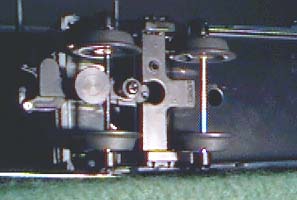
The new design was NOT present on the Archive 3 pack. Perhaps you have seen it on other Lionel cars? Lionel should try to move towards making it the standard for cars equipped with the sprung metal truck. In addition to working smoothly and does not need as much pull down effort to uncouple unlike some of the other manufacturers all metal trucks. I'm hoping that this indicates Lionel's direction to finally addressing operator problems that have remained unaddressed since MPC days.

Lionel Ships Small Motorized Units
Lionel Dealers recently received the two small motorized units reproduced as part of the Postwar Celebration series. Both the #68 Inspection Car and the #58 Rotary Snow Plow are true to the theme of the Series. In addition, both these units are becoming very expensive "finds" in their original postwar versions, so operators everywhere will welcome these new versions.
First let’s check out the inspection car. As the picture shows the colors are true to the original. (The original is on the left.)
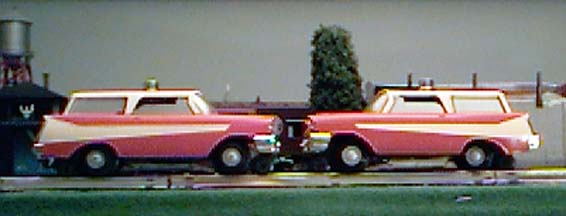
The finish I thought was perfect for a remake, in that I mean it’s not perfectly uniform. The new one does have a definite gloss appearance. It appears to be made from the original tooling and has the same control and drive mechanism. Both my postwar version and the new unit share a scratch inside the windshields where the silver rubs off. Inspection of the new unit shows that the rub is caused by the nut holding the upper edge of the brush plate. Lionel LLC applied a stick on rubber bumper to try to prevent the problem but it did not work. The new unit did not have that mark right out of the box, it appeared after initial operation, probably from vibration.
On the track it ran well and it was surprisingly quiet. I had lots of fun with it as I "drove" it around the track, and that too was true to the original. The major noticeable difference is shown in picture number 2 below, it’s the difference in the rear body fastener.
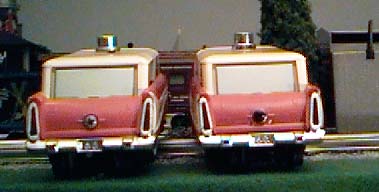 From a plain screw in the postwar version, to a blackened screw with brass collar in the new one, which should significantly reduce the possibility of cracking the body. (As a note you should, of course, avoid carrying the unit around by just lifting it up by the body due to the fragile body notch in the front of the unit.)
From a plain screw in the postwar version, to a blackened screw with brass collar in the new one, which should significantly reduce the possibility of cracking the body. (As a note you should, of course, avoid carrying the unit around by just lifting it up by the body due to the fragile body notch in the front of the unit.)
Rumor has it that Lionel cut dealer quantities on this item, so you may need to look around for one if you did not pre-order one. But it will be worth your search. Just imagine sending your track inspection team out to inspect a possible wash out on track 5. Well, You get the picture.
The second new arrival was the Great Northern Rotary Snow Plow. This item was previously re-issued in the Rio Grande road name, so the manufacturing process was in place for Lionel LLC. It too is color matched very well. I was disappointed in the lack of the spiral "swirl" on the rotary part of the plow. Since the swirl was present on the 1984 MPC version we can only speculate it was not done here to prevent parts swapping to repair postwar versions and passing them off as original. I would hope it was not a simple oversight on Lionel’s part, as I always like to believe they know their product better then we do.
This unit, like the inspection car, is great fun to play with, it’s popular with children and is somewhat prototypical, and it also seems to be in a better supply situation than the inspection car.

Last Two F-3’s of the Century Arrive
The Last two Lionel F-3s of this century have arrived. The Spirit of the Century, limited to a production run of 1000 looks good, but why talk about it as it very hard to find and pricing will cause you to have to dig very deep in your wallet. A serially numbered Certificate certifies its authenticity. It does have the usual premium operating features, but since it was developed as a pure collectable few will want to operate it. If you are looking for a premium F-3 Set and want to spend a little more than usual, try to track down the Century Club New York Central F-3, you will pay less than the Spirit version will wind up costing you and the NYC is protoypical and beautiful.
There will be passenger cars available for the Spirit and in the past Lionel has made more passenger car sets than engines which will put even more value on the Spirit Engines.
The Clear shell Platinum Ghost sports, in addition to its clear shell, platinum trim and the usual operating features, The Platinum Ghost has already appeared on several auction sites and appear to be readily available. Compared to The Spirit and The Century Club NYC they are the least expensive alterative. But they are certainly not prototypical. This is a collector piece that will have clear Madison Cars to go with it next year.
Both these new F-3s have Railsounds 4.0 with RPM control, but while it is touted as a new feature, it has actually been in the last few diesel railsounds chips as an unannounced feature. The RPM control is the ability to "rev" the sounds of a command control engine without engine movement. (In this mode the engine also ignores the axle speed sensor.)

Lionel News ... The June 1999 Dealer Letter
The following letter was sent to all Lionel Authorized Value Added Dealers on June 3rd 1999.
Subject: New Lionel Classic Catalog
Our next catalog will be available in early July,1999. We’re very excited about its contents and can’t resist a "sneak preview." Once you see it, you’ll understand why! It’s chock full of new products and new ideas. Here’s just a small sampling:
Last Train of the Century:
This is the last time the year will start with the number "19". That’s a pretty momentous event and we’re celebrating accordingly. We’ve picked our most famous and popular locomotive, the Lionel F3, and we’re offering it in two special editions:
The Platinum Ghost:
The shells are molded in clear polycarbonate with "Lionel Lines" markings. The truck sides, frames, and front pilot are all die-cast plated in precious platinum. It’s a stunning look! (Due to constraints in the plating process, this item will be produced in limited quantities and allocated.)
There’s also a set of clear-shelled Madison cars available for separate sale. The truck sides and car ends are similarly plated in precious platinum.
Spirit of the Century:
This is a spectacular celebratory deco scheme designed for us by a Lionel enthusiast living in Australia. It’s bright and colorful, Command equipped, and comes with a special Railsounds chip. But to make it particularly special, we are producing only 1,000 and a handsome Certificate of Authenticity, serially numbered from 1 to 1,000, will be included. (Matching aluminum passenger cars are also available.)
Lionel’s Largest Die-cast Locomotive Ever, The Allegheny 2-6-6-6:
It’s our first articulated steamer and it’s a beauty. Measuring 32 inches and weighing in just under 18 pounds, the detail and craftsmanship is magnificent, There are twelve nickel-rimmed drive wheels and it will be offered in the Virginian and C&O deco schemes. (These items will be produced in limited quantities on allocation.)
The Most Fascinating Locomotive Ever Built, The West Side Lumber Shay:
With its unique external drive mechanism and unusual appearance, this is a must for every layout. We know from experience in the Lionel Visitors Center that it will quickly become the center of attention among family and friends, This edition is Command-equipped, has a fan-driven smoke unit, and sports an actual Shay recording with our new RailSounds 4.0. We’ve also added prototypical log cars!
The Ultimate Starter Set:
You asked for it and here it is. At a suggested retail price under $400, this ready to run set includes a die-cast Hudson and tender with sounds and smoke. The set also debuts our new 80 watt transformer modeled after the one and only Lionel ZW.
The Lionel Archive Series:
It’s arguably the most hallowed spot in O gauge railroading The Lionel Archive contains samples of products that went into production and prototypes of some that never got there. We’ve reproduced three 6464 boxcar prototypes that were never produced as the first set in a new collectible series.
New Diesel Hauler:
RS-11: It’s all new and it’s a show-stopper. It’s near scale and we took extraordinary steps with the detail, from the pneumatic hoses in the front, to the die-cast fuel tank, fan-driven diesel smoke unit, and stamped metal handrails and chassis. It’s available with the popular New York Central or Delaware & Hudson markings.
Christmas Galore!
Celebrate the season with our beautiful Christmas Work Caboose loaded with presents. There’s also a Christmas boxcar that plays a popular recording of "Frosty the Snowman" and an operating car with an elf chasing poor Rudolph around and around. And, of course, there are the traditional dated cars, large scale Santa handcar and ready to run decorative set.
Lionel Heavies:
Our most popular boxcars now come with an optional die-cast frame at a great price. You can feel the quality.
Lionel Route 66:
Mike Fulmer has designed two more incredible accessories to the Lionel Route 66 Series that began with the Dino Café. The UFO Café and the Hindenburger Café are more colorful and creative than any accessory you’ve ever laid eyes on.
Fun,Fun,Fun!
From the King Tut Transport Car to the bobbing Halloween Witch Car, nobody makes railroading more fun than Lionel. They’re designed especially for your young customers-and those that are still young at heart!
And Much,Much More!
This is only a small sampling of the wonderful products you’ll see in our upcoming catalog. Expect delivery in early July. In the meantime make sure your customers know the Lionel is the REAL leader in O gauge railroading!

Geeps Arrive From Lionel
Wabash 3 Piece Lash Up, Postwar Celebration Series Burlington GP-7, and
The Baltimore & Ohio GP-9
I have reviewed the GPs before, but these three models were the first ones that I have had with the diecast fuel Tank, and the additional weight of diecast steps and pilots. The first thing you will notice is the additional weight the diecast extras add. I couldn't wait to compare them with the older models on the layout.
Let me tell you what was on the layout already....When the Milwaukee GP-9s first came out I purchased 2 of them to run them as a Lash-Up (I love the Milwaukee Road). When the non-powered Calf came out I put it into service in the middle of the two powered. This twin motored three piece set has been on the layout ever since pulling a long train of mixed postwar and modern cars. These early Geeps had plastic tanks and steps and therefore are considerably lighter than the Wabash Units. How would the Wabash stack up in comparison?
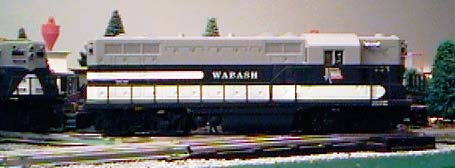
First Lets Make the Quality Statements...
The First Set of Wabash Geeps suffered from a "Shaved" window area that was then painted over. Another unit had one black coupler and one shiny "natural" one (I've seen several like this, seems to be a common problem). The Third Unit also had two small indents on the roof. The second set of Three passed my severe visual inspection, but the program/run switch will only go into the "program" mode if you apply upward finger pressure while you are programming. I've decided that since the bodies are nice this small problem is "acceptable" and the Wabash units being Heritage have a lifetime warranty anyway. All Powered units had the "Tested By" quality control sticker on them, indeed one unit looked as though there were quite a few test track minutes on it.
Now Lets Put in the Batteries...
This was not pleasant. Lionel has made the electronics bigger, I believe in the name of modularization.

The battery clip is now in a location right behind the motor. There in the midst of wires and quick disconnects is where they want the battery to be. Make sure you position your battery properly  (which is horizontally), allowing the motor to turn freely (as shown in the photo). As long as we are talking about removing the cab...Lionel, move the two rear screw locations away from the rear truck, and make everyone's life a little easier!
(which is horizontally), allowing the motor to turn freely (as shown in the photo). As long as we are talking about removing the cab...Lionel, move the two rear screw locations away from the rear truck, and make everyone's life a little easier!
Now Lets Run Them...
On the track they went, they pulled that 11 car freight (and the Wabash Dummy) around with very little effort. And what an interesting sound effect the two powered units provide, in that their diesel engines do not quite sync perfectly making an interesting and realistic warble sound. The brake sounds are very loud and have the perfect annoying screech sound. If you want to run the units separately, you'll find both horns unique.
With the preliminary running out of the way, I decided to go right to the extreme test. A Single Wabash Geep would attempt to pull the same long freight around. Well, it was a success, a rousing success, even passing through some of my sharper O turns from a complete stop, the unit spun much less that the Milwaukee Road Geep on startup. You might also want to note, that if you have areas of uneven track the diecast tank seems to not quite hang down as low as the plastic tank of the earlier Geeps. I like the look and the operation of this 3 piece set, I think you will too.
Burlington GP-7:
Beautiful in appearance and with all the features of the Wabash Powered Units. You will notice the unnumbered number boards, just like its postwar predecessor. Quality was very good on the two units I inspected. The silver and red is sharp and looks exactly as I would have expected a new Burlington to look in 1955 (of course I was only 2.)
Baltimore & Ohio GP-9:
Not quite as nice as the catalog photo but very close. Another mismatched coupler set (Note to Lionel, they should match either 2 black or 2 natural!) But I was able to blacken mine pretty easily, and the extra striping makes this a sharp looking diesel.

Lionel Bulletin
Gary Moreau Removed...Press Release Follows
Lionel announces President and Chief Operating Officer Richard Maddox to assume the helm of Lionel L.L.C.
New York, July 26, 1999 .. Wellspring Associates L.L.C. today announced the appointment of Mr. Richard N. Maddox as the President and Chief Operating Officer of Lionel L.L.C. effective immediately. Richard joins Lionel from Bachmann Industries where he was most recently, Senior Vice President Sales and Marketing.
"Richard's experience, intimate knowledge of the industry and business, and his tremendous success in this industry over the past forty years made him an ideal candidate to execute our plans and strategies and to extend Lionel's market leadership,"said Martin Davis. Managing Partner, Wellspring Associates L.L.C.
"We at Lionel have known about Richard's excellent reputation in this market and in joining Lionel L.L.C., he will significantly strengthen our management team" commented Davis.
Maddox said, "I am delighted to have the opportunity to lead Lionel into its second century. Lionel is a company that I have admired for many years and as its new President, I look forward to serving our customers in the traditions of Joshua Lionel Cowen when he founded the corporation nearly one hundred years ago. There is no question in my mind that Lionel has all the ingredients to continue to lead this industry with world class innovation, best of breed engineering and manufacturing, and superior customer service."
Lionel L.L.C. is today's market leading toy train manufacturer will be celebrating its centennial anniversary in the year 2000. Lionel has been at the center of every major innovation in toy train manufacturing since its inception.
Today Lionel continues to be the market-leading innovator in the toy train industry with such technology leadership in total layout management and operating systems called TrainmasterTM, the market leading layout electronics technology capability, Lionel has also been at the forefront of the most advanced sound capability in the market today with its Railsounds 4.0 true sounds system.
Maddox to Focus on New Competitive Focus for Lionel
Richard will assume full day to day operating responsibility for Lionel at its primary headquarters and manufacturing location in Chesterfield, Michigan.
His initial efforts will be centered on creating new competitive product and channel strategies for Lionel as it enters its second hundred years of continuous operations.
Richard said, "Our customers continue to be very loyal to the Lionel Brand. They expect product excellence and value from Lionel. We will not disappoint them. Lionel will produce the highest quality, most innovative, affordable products while maintaining the tradition that Lionel has carried for nearly 100 years."
The future strategy of Lionel will be to continuously provide market-leading innovation and technology, as it has done so well in the past. Advanced engineering disciplines including electronics and sound engineering will play a major role in the entire product line that Lionel brings to market as it enters the new century of Lionel.
Maddox Background and Highlights
Prior to joining Lionel L.L.C.. Richard was Senior Vice President. Sales and Marketing, for Bachmann Industries where he responsible for establishing Bachmann as a significant market player in the toy train industry. Under his leadership, Bachmann was recognized by Model Railroader Magazine as delivering to the market, based on a "Readers Choice" annual survey, the "Best of the Best" in model railroad toy trains.
About Lionel L.L.C.
Lionel L.L.C. (www.Lionel.com) is the worldwide leader in toy train manufacturing with headquarters and manufacturing facilities in Chesterfield, Michigan. Lionel L.L.C. serves primarily the "0" gauge toy train and accessories market along with a presence in "G" gauge, or garden railroading. Lionel trains are the most valued toy trains in the market today being collected or operated by over 100,000 toy train hobbyists. Lionel has as its core competencies, superior to world class product engineering, extensive technology rich manufacturing, both subassembly and final, and superior customer service. Lionel sells its products through a nationwide distributor and dealer network, the largest in existence today. Recently Lionel began to offer its collectible products over the Internet, again pioneering the distribution of toy trains in the market.

The Century Club 671
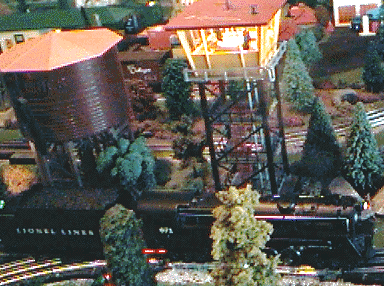
Finally after months of waiting (and two repair trips to Michigan), I have finally had a chance to put some time on the Century Club 671. First of all the engine is the usual Turbine type, noisy while operating but even without magne-traction it's a fair puller. The tender sits very far back from the engine, subtracting from the overall appearance. The wire tether is anchored in the tender, thus its excess length cannot be "tucked back" into the tender, also subtracting from its appearance.
This is the first Lionel engine with a motorized smoke unit, and it works very well, perhaps too well (but I'll NEVER complain about that). The sounds are authentic and impressive. Overall a nice piece...
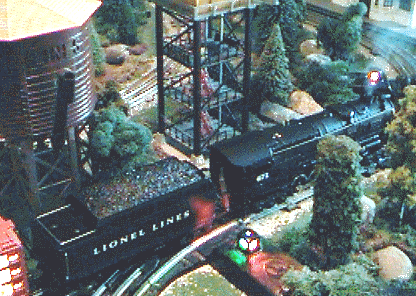
But, This engine is not as nice as the CC-726, not as good a runner, not as nice in appearance, thus I would say it's overpriced. The Tender announced for later this year will hopefully help in the appearance area, but is also an expensive addition. ($299.00)
Things to watch out for:
- Loosening of the linkage bolts connecting the linkage to the drive wheels
- Don't let the smoke unit go empty
- Don't let the smoke fluid block the stack opening
- Don't scratch paint off the tender trucks when removing the tender screws to put in a battery
- Oil the small lubricator linkage to lengthen its life.
- If your tender trucks have been touched up- and you don't like the looks of them, get them replaced. Lionel admitted on my return sheet that the trucks were indeed "touched" up with magic marker.
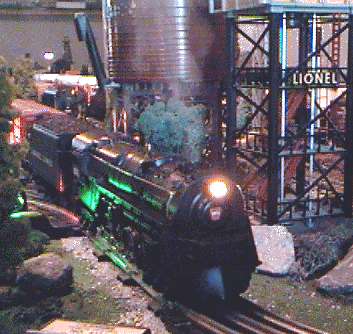

The Century Club - GG-1
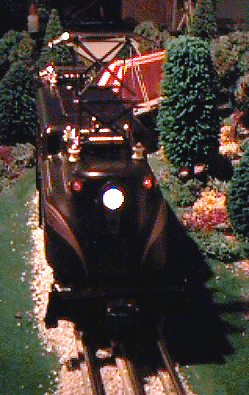
This is the one that I was waiting for from the minute I joined the Century Club. I own a Postwar 2360 that I purchased about 15 years ago, but that one sits in a case on top of my computer desk.
This is the engine I thought would be the most realistic of the Century Club engines. The digital recording is different and very realistic. I especially like the shut down sound on the panagraph breaking contact with the cantenary system. It sounds like someone being zapped.
The insulators are white, unlike the MPC GG1's which came with black ones. The nylon idler gears are out and metal gears are in and it runs very well. But maybe I'm a bad person to review this engine...I just love it.
The engine has newly designed LCRU and sound boards. These will probably be the same ones used in the soon to be released NYC NW-2 Switcher, just with a different sound chip.
The front and rear trucks are modified to accept the electro-couplers. My shell (and the several others I've seen) were all excellent. I have heard of pitted areas on some of them
The problems I've seen/heard of include:
- No lubrication
- Scratches on the roof
- Broken panagraph mounting rivet
- not loud enough
- CC board problem
- Stripes not properly aligned
The engine comes pre-installed with an Ever-Ready Industrial energizer. My inner box was clearly marked to this effect. This will make for a difficult decision for those that don't want to open the GG-1
This is an excellent Engine and one that I'm sure will increase nicely in value
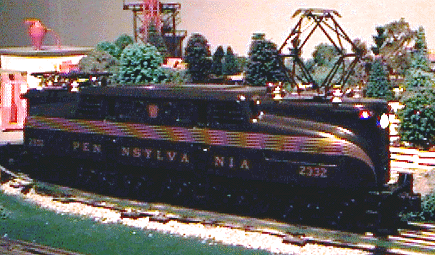

Lionel Holiday Sound Car
Lionel Shipped the Heritage Holiday Sounds boxcar this week. It plays a Neil Young mixed version of Silent Night. It also does random "HO HO HO's" and sleigh Bells. If you press and hold the whistle button down on you transformer, (or the whistle of a Cab-1 when used with a Powermaster) there is a slight delay (to let the horn/whistle of the engine finish) then a distant "HO HO HO Merry Christmas" is heard.
For those expecting additional sounds for the $199.95 Heritage price ........SORRY
Overall I like it, but it's really expensive. In addition it was expected to be in short supply, but at my dealer they were all over the place. He's got 3 weeks to sell them.
Return to the Lionel Library Index

Bascule Bridge
If you ordered a new Bascule Bridge...YOU WIN!!!...They are absolutely beautiful and work great. Lionel shipped exactly the quantity ordered and when everyone sees how well they were done...they're sold!!. The Bascule Bridge is not in the 1998 catalog I doubt that Lionel can make enough on each bridge to justify running it again with out a price increase, we'll probably see it again in a few years.
Lionel did a great job on the bridge. They listened well to the buying community that remarked how cheap and "plastic looking" the 164 Log Loader remake was last year. Then they created a product every bit as good an operating accessory as the original. The only thing I could even think about it that I didn't like, is the shanty windows could use some type of opaque glass (like the lift bridge) so that you can't see the circuit board. How's that for insignificant??
Return to the Lionel Library Index

New York Central J1-e Hudson
I had not originally ordered the Hudson, mainly because I did not believe the Vanderbilt tender could negotiate the curves on my O42 Layout. Once I saw that the engine could navigate that O42 radius curve, I decided to pick up one. As I watched it go around the track it looked great and the railsounds sounded good.
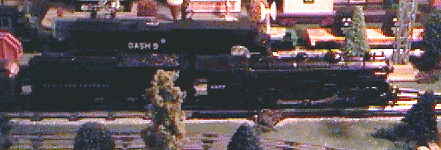
I watched several opened for delivery...the first could barely crawl around the track. Another had a very rough Engine casting and was not accepted by the buyer. 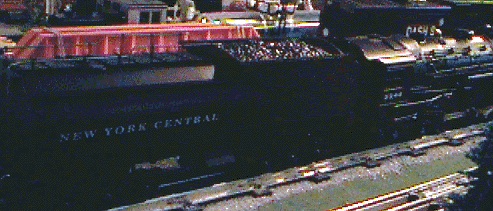 The lower toolboxes of the tender are hollow plastic and I saw one reject with one of them snapped off. (A good reminder...don't try to lift the tender out of the box by either the railings or toolboxes.) Another engine was missing piping pieces. Another one could barely move because the brass axle bushings were rubbing against the drive wheels. You must get the picture by now, and I can't even get a new TV without getting a reject.
The lower toolboxes of the tender are hollow plastic and I saw one reject with one of them snapped off. (A good reminder...don't try to lift the tender out of the box by either the railings or toolboxes.) Another engine was missing piping pieces. Another one could barely move because the brass axle bushings were rubbing against the drive wheels. You must get the picture by now, and I can't even get a new TV without getting a reject.
I opened the outer carton at the store and put the engine on the track, visually it was ok, except a small pin dot of missing paint on the steam chest, so far, so good..Now the big test. I put the Locomotive and tender on the track and fired it up, it creeped out on full power, unable to pull even a small consist of cars. It's interesting to note, that while there are visual inspection stickers on the outer bags, these units did not appear to have been run, and did not have the "tested by" QA stickers on either unit.
I thought I saw possibilities and since it appeared visually O.K. I took the Hudson home. Once home I immediately oiled every piece of linkage, every contact point, and the three grease reservoirs on the underneath of this engine. Then as it showed in the owners manual, I removed the rear ash pan and lubricated both ends of the armature shaft. Once the engine was lubed fully I put it on the track to see if it would now pull any better.
After a few circles around my loop the engine started to loosen up and move at a speed similar to the 1990 Hudson, which is the same basic engine. The Hudson doesn't move at the same speeds as the smaller "baby" hudsons and the berkshires do. I tried some older freight cars and the engine pulled them around at a brisk, constant speed. I now have logged about 8 hours on the engine and it continues to "break-in", it now starts very smoothly and people who see it appreciate its looks and sounds. Oh, and it's a great smoker (in fact every one I've seen has been a great smoker) synchronized perfectly to the steam sounds. Add in the wireless tether and the realism is enhanced.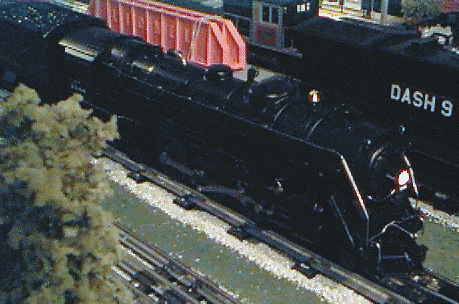
The new Vanderbilt tender is sharp, although not exactly as pictured in the catalog, it is very nice except for the poor looking plastic coal load, which covers the battery and the steam chug switch.
Final evaluation, A good engine, but a lot of out of the box defects. Some samples might have problems pulling the heavyweight cars it was designed to be used with.
Return to the Lionel Library Index

Pennsylvania Torpedo
Many Century Club members complained about the casting defects of the Century Club Hudson, they should definitely stay away from the new Pennsylvania Torpedo. First inspection of the engine revealed many casting indents and several bumps, which appear to be flecks that were painted over. I was shocked at how rough this casting was! The tender had a similar hair or fuzz defect that was again painted over. The engine ran very rough and the smoke was not synchronized to the steam sounds.
I took this piece back to the dealer and asked to see another unit, all three (mine the dealers display and the additional one we opened) were all very rough. This is a problem when you are looking at a 700 dollar engine! Anyway I selected, the additional one we had opened. This unit runs a little better, and the smoke was synchronized better. The tender on this unit was also much better, and the railsounds have a unique whistle for this unit, that I really like.
Lionel encloses a letter with each unit explaining the manufacturing difficulties it had with the pilot of the engine. It was to have had silver stripes as in the catalog shot, but there was no way they could accurately produce it. The engine is also a little "greener" looking than in the catalog. The gold stripes on the sides of this engine appear to be hand painted! One sample had a few flecks of gold paint where it shouldn't.
I would not rate this engine as high as the Wabash, or the Century Club Berkshire, but if you like the style, see if you can get the dealer to inspect it with you before you take it home or you may be disappointed with it.
Return to the Lionel Library Index

726 Century Club Berkshire

The first Century Club Engine has arrived...The 726 Berkshire..And it's a beauty. I have logged about six hours on this engine and have been pleased with its operation. I have noticed no wobble which has been a common problem with the six drive wheel engines. 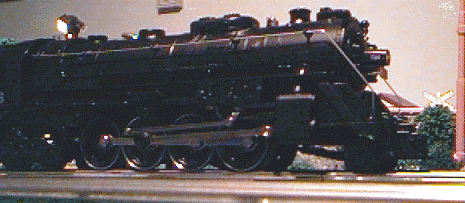 It growled just like any other Berkshire on startup and on corners, but most Berkshires need some amount of break-in time before they quiet down. The Baldwin Disk Drivers have spoke holes (unlike the drivers on the Wabash Hudson) which add extra realism. Out of the box the outermost linkage was bent, but I think that will be a common problem and is easily corrected. Just flip the engine over and pull out at the inner most point of the bend. The tight packaging probably causes fingers to press too heavily on the unit when boxed.
It growled just like any other Berkshire on startup and on corners, but most Berkshires need some amount of break-in time before they quiet down. The Baldwin Disk Drivers have spoke holes (unlike the drivers on the Wabash Hudson) which add extra realism. Out of the box the outermost linkage was bent, but I think that will be a common problem and is easily corrected. Just flip the engine over and pull out at the inner most point of the bend. The tight packaging probably causes fingers to press too heavily on the unit when boxed.
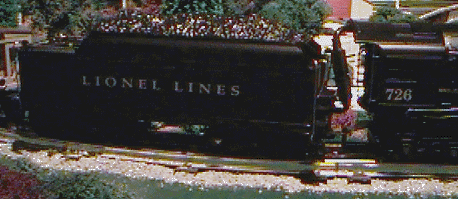
The tender is a die-cast 726W with all the sounds and the Electrocoupler on the back. The only disappointment with the tender is the plastic detail pieces used on the bottom of the unit. There is also plastic used for the rear boiler piping and inner cab detail, but you can't tell what it's made of by just looking and the extra detail is a nice addition. The 18K gold accents don't look as far out of place on an operators layout as I expected (or you might expect).
 I expect to use this engine heavily and will report as updates any problems that turn up. But in case there are problems this engine has a 5 year warranty, and comes with the Certificate of Authenticity and several blueprints from subassemblies of the engine.
I expect to use this engine heavily and will report as updates any problems that turn up. But in case there are problems this engine has a 5 year warranty, and comes with the Certificate of Authenticity and several blueprints from subassemblies of the engine.
Return to the Lionel Library Index

AEC Tank Car #1:
I had no intention of purchasing these cars, I was "talked" into ordering them by one of the guys at the shop I deal with. Below are a couple of photos that come "nowhere near" showing how really neat this first tank Car is.
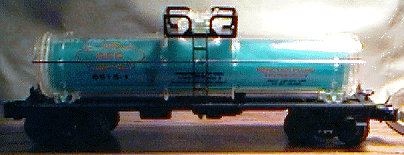 Here is the front View. The Car is very heavy, the liquid is held in a second inner tank, inside the outer tank car body. Note the blue color, it's really much nicer than the catalog.
Here is the front View. The Car is very heavy, the liquid is held in a second inner tank, inside the outer tank car body. Note the blue color, it's really much nicer than the catalog.
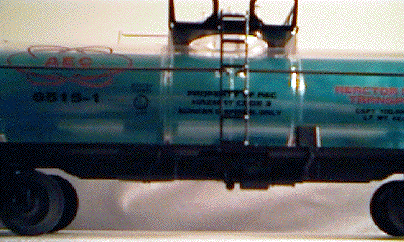 Here's a closeup of the lettering on the car, the light and dark blue shown here are really the way the car looks in person.
Here's a closeup of the lettering on the car, the light and dark blue shown here are really the way the car looks in person.
The liquid in the car will cause eye and skin discomfort, so the instruction sheet with the car says it's a "novelty item and not for children". The outside of the box still says "8 to adult", but does warn of the chemical nature of the car.
Now for the final word, Lionel apparently cut several dealers on this car. My dealer had none left for regular retail sales, and was short one for an early order customer. They look great and may be slightly "under manufactured". Could be a big winner for the collector community. You DID order one didn't you??
Update... All Three AEC Tank Cars have arrived at your dealer......
Return to the Lionel Library Index

Lionel Lenny Dean Letter:
Below is a letter that was sent to Lionel dealers this week explaining Lionel's side of the Lenny Dean Retirement story. From here it looks like a friendly split.
We cannot know for sure but we sure couldn't blame Lenny if he wanted to slow down stop traveling and enjoy life a little more.
And that's exactly what this letter would indicate.....
April 9, 1997
To: All Friends of Model Railroading
RE: LENNY DEAN
After a long and distinguished career at Lionel, which included managing the Lionel Service Department, Lenny Dean retired from Lionel in 1986. He then continued to work with Dick Kughn, however, as a full-time consultant. While Lenny continued to reside at his home in New Jersey, he worked with the Lionel team to produce many wonderful products and to establish Lionel as a visible and supportive force in the collector community and among the clubs.
With the loss of Dick's hands-on management in 1995, we have had to make many changes to the way we run our business. As a result of these ongoing changes, we have not been able to use Lenny's full-time services as a remote consultant. We have had to make the difficult decision, therefore, not to renew Lenny's full-time consulting agreement when it expires later this month.
It is our sincere hope that Lenny will continue to offer his services to Lionel on a part-time consulting basis. He provides an Important link to our past and we know that everyone enjoys his presence at industry events. Only Lenny, however, can decide whether or not such an arrangement fits in his plans for the future. After fifty-some years in the business, it would certainly be understandable if Lenny decided it was time to take a break.
We understand that a number of clubs wish to honor Lenny. All of us at Lionel encourage this well-deserved recognition and will be happy to consider our involvement with your event. I know you will appreciate, however, that it just won't be practical for us to participate in tributes with all
of the clubs that Lenny has worked with over the years. As always, please call Mike Braga at 810-949-4100 if you have any questions .
I hope you will join all of us at Lionel in thanking Lenny for the contribution he has made and wishing him the best of luck in the future.
Sincerely,
Gary L. Moreau
President
Return to the Lionel Library Index

D iesel Horns and Transformer Polarity:
iesel Horns and Transformer Polarity:
This is the time of year when a lot of complaints come in about the electronic diesel horns that come in the Lionel Starter sets. The usual complaint involves hors that just don't work. When put on the test track, however, they work just fine. What has been overlooked is the polarity of the wires going to the track, but these are A.C. Sets right? Well read on......
Most of the Lionel starter sets use a power supple that steps down the voltage from your wall outlet to a nice 16-18 volts, that is fed to the controller. The controller has a large knob to adjust the level of power to the track, and two push buttons. One button interrupts the power to the track and thus forces the the E-Unit Reversing board to cycle (if the switch on the locomotive is on...but that's a story for another day). The other button activates the horn.
The horn/whistle activation button uses diodes to place a DC pulse on top of the AC signal, the horn circuit board senses that pulse and sounds the horn. This is where polarity comes into play, if the pulse is in the wrong direction (say negative instead of positive) the board doesn't even know it's there and nothing happens.
In fact, this is how Lionel operates the sound systems on the more expensive engines that have both a whistle/horn and a bell. One pulse, (say positive) sounds the horn or whistle and the negative pulse sounds the bell. Reverse the polarity to the lockon and the opposite will occur.
The instruction manual that comes with these trains spells it out for you and the new controllers have marked wires coming from them, but if you every have a horn problem, switch the wires to the track First and see if that fixes your problem.
Return to the Lionel Library Index

Flatcar Melting Warning:
Did you order the 6-16954 New York Central Flatcar with Ertl® scraper? If you did you will want to open it and put something between the soft rubber tires of the scraper and the unpainted black flat car. All checked samples have shown deterioration, a kind of melting, of the plastic flat car apparently from a chemical in the tire.
Postwar collectors will remember that the old bright yellow #65 hand car in the early 60's was made with soft pliable rubber figures that eroded away the base of the hand car where the men were supposed to stand forever. Again from a chemical used to keep rubber soft and flexible.
On my personal unit, I have used small pieces of black electrical tape, just enough to prevent the wheels from coming into contact with the flatcar.
Lionel L.L.C. could probably have prevented the problem by painting the flatcar, something they have promised to do to all Lionel cars in the near future.
Return to the Lionel Library Index
Melted Flatcar Isolators Shipped to Dealers By Lionel:
Lionel has sent to dealers thin sheets of plastic to place under the Ertl® vehicles that were shipped earlier this year. (The most recent sets have contained the sheets.)
The sheets have a unique feature which is not always readily apparent. They are coated with a peel-off material that once removed from both sides of the sheet makes it appear shiny and very clear, and is not as unsightly as one would initially expect.
It still would be better to paint the cars instead of leaving them as unpainted plastic.
One more thing, if you leave your car in the box, the tires on the vehicle will react to the plastic backing in the box.
Return to the Lionel Library Index

Product Review: Santa Fe F-3's
OK, The Headdress on the B-Unit is backwards! If I received 1 E-Mail about this I received 100 E-Mails about this. One gentleman even called Lionel about it and was told they knew about it and they are all like that. It's too bad that that one mistake has turned off a lot of would be purchasers.
The Engine runs very well, it has a lot of pulling power, but seems to want to race, low speed functions are difficult to perform. Since the engine set is meant to be used with passenger cars, I guess that doesn't really hurt it too much, as it shouldn't be doing any yard work.
The sound system is becoming old hat now, the F-3 Horn is very realistic and the start-up and shut-down sounds continue to impress.
I don't rate this engine as good a buy as the Wabash Steamer reviewed here earlier, but if you like the Santa Fe Paint scheme, this is the first one to have the correct yellow stripe running up the nose!
Return to the Lionel Library Index

Shunted Motor Brushes
Lionel Announced with the printing of the 1996 Dealer Parts Listing that they would no longer stock or ship the standard motor brush that has been the mainstay of the large AC motor for over 50 years. You know what a motor brush is, it's the round slotted soft carbon piece that transfers electricity to the top of the armature. It's the piece that old Lionel service directories warned you not to get oil soaked.
But, Lionel still makes this large AC motor, so what's the difference, what did they replace the old design with? The answer is a "shunted" motor brush with a braid that can be soldered directly to the brush plate and brush wire. Lets think about the design...
The old models consisted of a brass brush holder built into the top motor cover. Two brush springs fit into the slot in the top of the brushes applying pressure to the brushes assuring good electrical contact to the copper top of the armature.
Newer MPC Engines did not maintain consistent sizing of the Brush holders, And if a brush gets stuck, your motor dies. In addition, over the years, the size and strength of the brush spring itself has changed. These springs are smaller and weaker, in fact it is not unusual to see the spring tip burned off due to poor contact sparking. And to top it off the newer brushes are made of a material that just doesn't last very long, especially with high current sparking.
Lionel Trains Inc., several years ago came up with an idea to try to improve brush life and operation. They formed the brush itself with a braid of copper wire coming out of the top. This braid could then be soldered directly to the brush holder. This reduces sparking and heat generation. It eliminates the need for the brush spring to conduct current even if the brush holder is "out of round".
This new brush is now the only one in the parts list. While it doesn't seem to last any longer than the MPC brushes without the braid, they do seem to work well and make up for a lot of out of tolerance brush holders.
BTW, you can tell an original 50's style brush by its color, older brushes last longer because the metal alloy mix seems to more copper and less carbon, newer brushes seem to grind down easier. Why the change, well remember armatures are are newer and thinner too. Things just aren't made the way they used to be.
For the purists out there, you can still get the old style brush at shows and the major suppliers like:
George Tebolt
Box 149
Spencertown, New York
12165
Return to the Lionel Library Index

GE Dash-9 Engine:
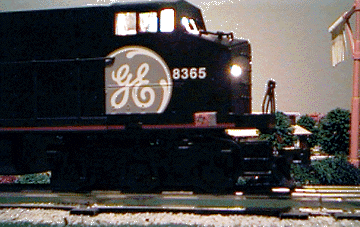
Here's another good, high quality, Command Control Engine from Lionel. The GE Dash-9 is the first Electro-Coupler Equipped Lionel diesel
The fun of being able to uncouple anywhere on the layout is something you get used to very quickly. Unfortunately it "devalues" your older engines. I have seen postings in chat rooms, that point out that before the latest Lionel items get to your dealer, the new catalogs are touting next years new features.
It's getting to be just like the computer wars, a 150 MHZ Pentium is barely available and the Computer Shoppers are talking about 166Mhz Pentium chip with MMX Technology.
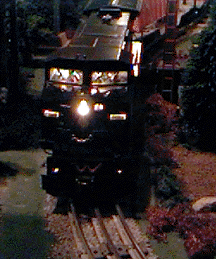
This Dash is a great puller, with lots of power. All the Lionel 6 wheel Magna-Traction Trucks seem to be excellent for the Operators. This goes back the the redesign done for the Original, Union Pacific Dash-8 manufactured several years ago.
The Southern Pacific due out later this year, will be identical to the GE Demonstrator, except it will have a Die-Cast Frame rather than stamped sheet metal. We'll have to wait and see what effect the additional weight will have on the performance of this unit.
This is a good looking nice running engine, which should be easy to find at your dealer.
Return to the Lionel Library Index

The Wabash Hudson with Trainmaster® Command Control and Railsounds II®
I have logged quite a few hours on my recently acquired Wabash Hudson with Command Control. While the item is a smooth runner it does exhibit the same tendency to wobble slightly down the tracks that all the small hudsons have shown in the past. Part of the problem is the sheet metal frame staked together to form the core center of the engine. Before you make any 1996 quality comments, keep in mind that I see many post war baby hudsons (646,2046,2055,2056,2065, etc.) that show the same problem. They run smooth but they wobble.
There were two items on my unit that I would consider defects, one slight and the other major. The minor one is a small blob of metal on the steam chest that went undetected and was painted over, it is barely noticeable, and I have looked at about ten of these engines and they all have some type of small casting or painting flaw. These are toys remember!!
The second defect was a bigger problem. When I started up the engine, it would make a sound like garbage cans tossed out on the ground. (Ah, a bonus sound I thought?) Then occasionally the sounds would cut out, well I thought it was a short and checked the wiring coming from the engine (That's how I found the blob of metal, I told you it was small.) I then decided to risk warranty violation and removed the Railsounds II board from the tender floor. Ignoring the directions, I checked the seating of the Wabash specific Railsounds Chip, the one that rides in the board upside down. It was in at an angle, not seated properly, I leveled it out and that fixed it. Apparently as temperatures in the tender changed the chip holder would expand and contract causing inconsistent contact. I'm happy to report it's working fine now.
The Engine looks great in its dark blue with white running board, and I hope in the future they will produce Madison Style Passenger Cars for it as the 1995 Catalog promised.
I can safely recommend this loco for you if you are looking for a Command Control Equipped engine and would like to spend about 1/3 less than the bullet nose N? Engine went for last year.
Return to the Lionel Library Index

Product Review:
1996 "Lionel Steel" Service Station Set
The 1996 Service Station Set arrived at my dealer this week and I couldn't wait to test this little baby out. It looks nice in its black and silver colors and Red Lionel Steel Logo. It is the first small engine to come Command Control equipped.
So, I opened it up to first inspect the paint and finish, and I really did feel that they had done a terrific job on this engine, the new bell, (used on the larger steam engines), adds nice detailing. I next inspected the cars, they weigh a ton! Again a nice paint job was evident, there were a couple of inward facing sharp edges of metal flash, but no-big-deal.
Time to run it, first without Command Control, no problems, nice bright directional lighting and it didn't seem as noisy as the postwar versions of these switchers. The instruction booklet, warns you about the noise and the slower speeds this engine runs at.
The gears looked a little dry to me, so I lubed it up per Lionel's instructions and put it to the Command Control test. Once again, it ran flawlessly, quieter than I expected and as I said before, it looks great.
Finally I thought about the heavy cars this small light engine was expected to pull, two die-cast cars come with the set and a third is on the way. Then I examined the engine further and noticed that Lionel has added a traction tire. This prevents any of the wheel slippage that we are all familiar with in the small Lionel engines.
All in all, a nice Service Station Set, probably very collectable, since it's a little boring. Street prices are in the $369.00 to $399.00 range.
Return to the Lionel Library Index

Operating Switch Tower
Lionel has released the new Operating Switch Tower, it has an orange box and the number 445 on the outside....That's where the similarity ends. To start off it's made in China, Yes, ALL of it.
Secondly instead of the simple coil activator and nylon cord that "allows" the second worker to run down the stairs, it now has a complex geared motor sub-assembly that looks nice, works well, but is a complex fix if anything ever goes wrong.
The nicest improvement is to the second story door, which now opens and closes with the exit of the upstairs worker.
I make no recommendation here, but my layout will continue to contain an original 445.
Return to the Lionel Library Index

Oh, Those Coupler Problems...
Lionel couplers can be most frustrating if they keep coming open, usually at the point on your layout where the runaway can cause the most problems. The postwar designs always used some type of pull down metal armature, and a spring. This spring assured you that the coupler armature wouldn't "fall down", opening the knuckle and sometimes sparking down the track. Actually, when you replace the spring sometimes they "want" to stay closed, and a lot of voltage is needed at the magnetic uncoupling track to open them.
Obviously, if you know the part numbers for this type of coupler you can easily replace the spring, or for a regular car the entire coupler plate can be purchased and easily fastened to the axles of the truck.
Unfortunately, when General Mills purchased Lionel from the Struggling Lionel Corporation in 1969, one of the first things they worked on was a redesign of the common freight truck.
Call it cost savings, Lionel called it an "improvement", what came to pass was the "symington" plastic truck with the now infamous Delrin Plastic, Thumbtack activated pull down armature. Slowly the plastic armature spread to almost all of the MPC couplers no matter how much weight they were expected to pull (check the tender on the 1985 "783" Hudson, yep, it's plastic).
This plastic armature with the thumbtack has been the cause of more crashes in Lionelville than any case of operator error. So much so, that Lionel finally issued a service bulletin announcing to the world how to fix/tighten the plastic armature. Since Service Stations were fixing these things anyway the bulletin must have been more for public consumption, anyway I'd like to just briefly tell you how to do it on your newer cars that keep coming un-coupled......
- Remove the wheel set from the truck
- Position the truck upside down and the knuckle end on your right
- Insert a screwdriver blade under the plastic armature. It snaps into a hole furthest from the knuckle, the other hole closer to the knuckle is just a guide hole. You want the blade of the screwdriver between the holes.
- Put your finger on the top of the plastic armature on the other side of the screwdriver.
- Turn the screwdriver clockwise, and the armature should pop out.
- With that done, hold the armature between your thumb and forefinger, thumbtack up, and squeeze it together to increase the bend.
- Snap it back into place and it should now arch upward to more securely hold the knuckle closed.
When you do this keep in mind these armatures are sometimes brittle and might break when you try to bend them. Also some have a "memory" and won't stay fixed. In both of these cases it pays to keep a couple of new armatures in your parts box.
Return to the Lionel Library Index

SC-1 Overloads
Operators of the new Trainmaster Command System who want to use the new hand-held controller with the SC-1 to control all their accessories are going to be disappointed or will need to do a little improvising.
The SC-1 Remote Switch and accessory controller is made to work with the CAB-1 Hand-held controller and the Command Control transmitter to operate 4 Switches and 2 accessories. In the instructions no Postwar accessories with any motors or large coils were shown.
Well, we put it to the test and in tests the SC-1 remote switch and accessory controller cannot successfully supply the ground path to run older accessories like a 164 or 364 log loader. The Train Station, in Mountain Lakes, New Jersey has had some success using relays controlled by the SC-1 and then using the relay output terminals to control the power hungry older accessories. The store hopes to test and then select the proper relay for ease of use, power requirements and packaging. If and when these units become available, you will read about it right here!
Return to the Lionel Library Index

Miscellaneous Lionel Notes:
Lionel has shipped the new Commodore Vanderbilt, it looks great, but it really doesn't run so well! It sounds great, but my sample had a nasty wobble which was very annoying even on O72 curves.
I can't comment on their sales, since they arrived so near to Christmas and are a "big ticket" item.
The cars to match this engine have been delayed until late January, that's a little surprising since they may have been made overseas anyway.
Also in the latest shipment was the target launcher car, you remember the one that elevates the balloon as the train moves around the track. it works very well and has been fun to play with. It is however just as annoying as the original one!
Return to the Lionel Library Index

Product Review: Southern Pacific GP-9
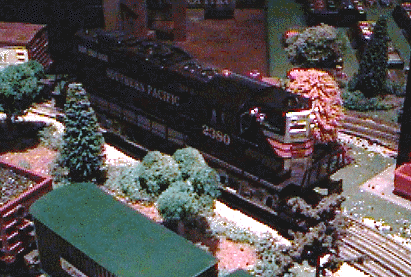 This is the one, the one engine you need to do that yard work or pull those freight consists down those passing sidings!
This is the one, the one engine you need to do that yard work or pull those freight consists down those passing sidings!
I like this engine, (and its twin the NYC 2380) they run quietly, look pretty and have the new signal sounds and command control.
The pricing is reasonable for all these features, since the catalog price is $299.00. Now that some of the dealers are reported as having sold out of these items, we can expect the price to start creeping up.
The silver trucks on the Southern really set it off, and it doesn't seem to slip as much as some of the other magna-traction geeps of recent years. On a scale of 1-10 this baby is a solid 9.
In fact the ONLY thing I could find not to like about this great pair, is the use of nylon idler gears in the motor truck. That's one of the reasons that it's so quiet, time will tell if those gears hold up well.
If you need some all purpose diesel power on your railroad, or want to get your feet wet with command control, this is the engine I would recommend!
Have Fun!
Return to the Lionel Library Index
Product Review: Warhorse Set
 Boring that's what this set is! The engine and caboose are nice enough, the recorded railsounds of a dying J are neat and very realistic. Unfortunately, I wish there was something that attracted me to this set, you know, something that set it off, that makes it a "have-to-have".
Boring that's what this set is! The engine and caboose are nice enough, the recorded railsounds of a dying J are neat and very realistic. Unfortunately, I wish there was something that attracted me to this set, you know, something that set it off, that makes it a "have-to-have".
Alas, it's nice, it runs well, it sounds O.K. I just find it hard to recommend to all of you. It's $1295.00 for crying out loud! I would suspect there will be some substantial price reductions on this set later in February.....
Return to the Lionel Library Index

Author: Steve Morris
Last Updated: Saturday August 7, 1999
Lionel® is a registered trademark of The Lionel Corporation, L.L.C.
Trademarks and Artwork © 1996 Lionel L.L.C.
Articles © 1997, 1998, and 1999 Montana Services
All Other Trademarks used herein are the property of their respective owners.
![]()


 From a plain screw in the postwar version, to a blackened screw with brass collar in the new one, which should significantly reduce the possibility of cracking the body. (As a note you should, of course, avoid carrying the unit around by just lifting it up by the body due to the fragile body notch in the front of the unit.)
From a plain screw in the postwar version, to a blackened screw with brass collar in the new one, which should significantly reduce the possibility of cracking the body. (As a note you should, of course, avoid carrying the unit around by just lifting it up by the body due to the fragile body notch in the front of the unit.)

 (which is horizontally), allowing the motor to turn freely (as shown in the photo). As long as we are talking about removing the cab...Lionel, move the two rear screw locations away from the rear truck, and make everyone's life a little easier!
(which is horizontally), allowing the motor to turn freely (as shown in the photo). As long as we are talking about removing the cab...Lionel, move the two rear screw locations away from the rear truck, and make everyone's life a little easier!





 The lower toolboxes of the tender are hollow plastic and I saw one reject with one of them snapped off. (A good reminder...don't try to lift the tender out of the box by either the railings or toolboxes.) Another engine was missing piping pieces. Another one could barely move because the brass axle bushings were rubbing against the drive wheels. You must get the picture by now, and I can't even get a new TV without getting a reject.
The lower toolboxes of the tender are hollow plastic and I saw one reject with one of them snapped off. (A good reminder...don't try to lift the tender out of the box by either the railings or toolboxes.) Another engine was missing piping pieces. Another one could barely move because the brass axle bushings were rubbing against the drive wheels. You must get the picture by now, and I can't even get a new TV without getting a reject.

 It growled just like any other Berkshire on startup and on corners, but most Berkshires need some amount of break-in time before they quiet down. The Baldwin Disk Drivers have spoke holes (unlike the drivers on the Wabash Hudson) which add extra realism. Out of the box the outermost linkage was bent, but I think that will be a common problem and is easily corrected. Just flip the engine over and pull out at the inner most point of the bend. The tight packaging probably causes fingers to press too heavily on the unit when boxed.
It growled just like any other Berkshire on startup and on corners, but most Berkshires need some amount of break-in time before they quiet down. The Baldwin Disk Drivers have spoke holes (unlike the drivers on the Wabash Hudson) which add extra realism. Out of the box the outermost linkage was bent, but I think that will be a common problem and is easily corrected. Just flip the engine over and pull out at the inner most point of the bend. The tight packaging probably causes fingers to press too heavily on the unit when boxed.
 I expect to use this engine heavily and will report as updates any problems that turn up. But in case there are problems this engine has a 5 year warranty, and comes with the Certificate of Authenticity and several blueprints from subassemblies of the engine.
I expect to use this engine heavily and will report as updates any problems that turn up. But in case there are problems this engine has a 5 year warranty, and comes with the Certificate of Authenticity and several blueprints from subassemblies of the engine. Here is the front View. The Car is very heavy, the liquid is held in a second inner tank, inside the outer tank car body. Note the blue color, it's really much nicer than the catalog.
Here is the front View. The Car is very heavy, the liquid is held in a second inner tank, inside the outer tank car body. Note the blue color, it's really much nicer than the catalog. Here's a closeup of the lettering on the car, the light and dark blue shown here are really the way the car looks in person.
Here's a closeup of the lettering on the car, the light and dark blue shown here are really the way the car looks in person. iesel Horns and Transformer Polarity:
iesel Horns and Transformer Polarity:

 This is the one, the one engine you need to do that yard work or pull those freight consists down those passing sidings!
This is the one, the one engine you need to do that yard work or pull those freight consists down those passing sidings!